Elevated-Temperature Performance, Combustibility and Fire Propagation Index of Fly Ash-Metakaolin Blend Geopolymers with Addition of Monoaluminium Phosphate (MAP) and Aluminum Dihydrogen Triphosphate (ATP)
Abstract
1. Introduction
2. Materials and Methods
2.1. Materials
2.2. Synthesis of Blended Geopolymer
2.3. Thermal Exposure
2.4. Testing and Characterization
3. Results and Discussion
3.1. Visual Observation
3.2. Mass Loss
3.3. Compressive Strength
3.4. Microstructural Analysis
3.5. Phase Analysis
3.6. Chemical Bonding Analysis
3.7. Combustibility
3.8. Fire Propagation
4. Conclusions
Author Contributions
Funding
Institutional Review Board Statement
Informed Consent Statement
Data Availability Statement
Acknowledgments
Conflicts of Interest
References
- He, P.; Wang, M.; Fu, S.; Jia, D.; Yan, S.; Yuan, J.; Xu, J.; Wang, P.; Zhou, Y. Effects of Si/Al ratio on the structure and properties of metakaolin based geopolymer. Ceram. Int. 2016, 42, 14416–14422. [Google Scholar] [CrossRef]
- Heah, C.Y.; Kamarudin, H.; Mohd Mustafa Al-Bakri, A.; Mohamed, B.; Luqman, M.; Nizar, K.; Liew, Y.M. Effect of alkali concentration on mechanical properties of kaolin geopolymers. Rom. J. Mater. 2012, 42, 179–186. [Google Scholar]
- Yang, K.H.; Cho, A.R.; Song, J.K.; Nam, S.H. Hydration products and strength development of calcium hydroxide-based alkali-activated slag mortars. Constr. Build. Mater. 2012, 29, 410–419. [Google Scholar] [CrossRef]
- Rivera, O.G.; Long, W.R.; Weiss, C.A., Jr.; Moser, R.D.; Williams, B.A.; Torres-Cancel, K.; Gore, E.R.; Allison, P.G. Effect of elevated temperature on alkali-activated geopolymeric binders compared to portland cement-based binders. J. Cem. Concr. Res. 2016, 90, 43–51. [Google Scholar] [CrossRef]
- Zhang, H.Y.; Qiu, G.H.; Kodur, V.; Yuan, Z.S. Spalling behavior of metakaolin-fly ash based geopolymer concrete under elevated temperature exposure. J. Cem. Concr. Compos. 2020, 106, 103483. [Google Scholar] [CrossRef]
- Shuai, Q.; Xu, Z.; Yao, Z.; Chen, X.; Jiang, Z.; Peng, X.; An, R.; Li, Y.; Jiang, X.; Li, H. Fire resistance of phosphoric acid-based geopolymer foams fabricated from metakaolin and hydrogen peroxide. Mater. Lett. 2020, 263, 127228. [Google Scholar] [CrossRef]
- Ramagiri, K.K.; Kar, A. Effect of high-temperature on the microstructure of alkali-activated binder. J. Mater. Today Proc. 2020, 28, 1123–1129. [Google Scholar] [CrossRef]
- Peng, X.; Li, H.; Shuai, Q.; Wang, L. Fire resistance of alkali activated geopolymer foams produced from metakaolin and Na2O2. Materials 2020, 13, 535. [Google Scholar] [CrossRef] [PubMed]
- Fan, F.; Liu, Z.; Xu, G.; Peng, H.; Cai, C.S. Mechanical and thermal properties of fly ash based geopolymers. Constr. Build. Mater. 2018, 160, 66–81. [Google Scholar] [CrossRef]
- Vickers, L.; Pan, Z.; Tao, Z.; Van Riessen, A. In situ elevated temperature testing of fly ash based geopolymer composites. Materials 2016, 9, 445. [Google Scholar] [CrossRef]
- Elimbi, A.; Tchakoute, H.K.; Kondoh, M.; Manga, J.D. Thermal behavior and characteristics of fired geopolymers produced from local Cameroonian metakaolin. Ceram. Int. 2014, 40, 4515–4520. [Google Scholar] [CrossRef]
- Van Riessen, A. Thermo-mechanical and microstructural characterisation of sodium-poly (sialate-siloxo) (Na-PSS) geopolymers. J. Mater. Sci. 2007, 42, 3117–3123. [Google Scholar]
- Rovnanik, P.; Safrankova, K. Thermal behaviour of metakaolin/fly ash geopolymers with chamotte aggregate. J. Mater. 2016, 9, 535. [Google Scholar] [CrossRef]
- Cheng-Yong, H.; Yun-Ming, L.; Abdullah, M.M.; Hussin, K. Thermal resistance variations of fly ash geopolymers: Foaming responses. Sci. Rep. 2017, 7, 45355. [Google Scholar] [CrossRef]
- Moukannaa, S.; Nazari, A.; Bagheri, A.; Loutou, M.; Hakkou, R. Thermal resistance of alkaline fused phosphate sludge-based geopolymer mortar. In Proceedings of the 13th International Conference of Modern Building Materials, Structures and Techniques, Vilnius, Lithuania, 16–17 May 2019; VGTU Press: Vilnius, Lithuania, 2019. [Google Scholar]
- Nobouassia Bewa, C.; Tchakouté, H.K.; Fotio, D.; Rüscher, C.H.; Kamseu, E.; Leonelli, C. Water resistance and thermal behavior of metakaolin-phosphate-based geopolymer cements. J. As. Ceram. Soc. 2018, 6, 271–283. [Google Scholar] [CrossRef]
- Wang, Y.S.; Dai, J.G.; Ding, Z.; Xu, W.T. Phosphate-based geopolymer: Formation mechanism and thermal stability. Mater. Lett. 2017, 190, 209–212. [Google Scholar] [CrossRef]
- Yu, C.Q.; Yu, Y.R.; Zhao, Y.M.; Han, S.; Wang, C. Preparation and performance analysis of high temperature resistant and high strength alcohol soluble phsophate/phenolic hybrid adhesive. J. Mater. Sci. Nanotechnol. 2019, 7, 206. [Google Scholar]
- Nazari, A.; Bagheri, A.; Sanjayan, J.G.; Dao, M.; Mallawa, C.; Zannis, P.; Zumbo, S. Thermal shock reactions of Ordinary Portland cement and geopolymer concrete: Microstructural and mechanical investigation. J. Constr. Build. Mater. 2019, 196, 492–498. [Google Scholar] [CrossRef]
- Saridemir, M.; Severcan, M.H.; Ciflikli, M.; Celikten, S.; Ozcan, F.; Atis, C.D. The influence of elevated temperature on strength and microstructure of high strength concrete containing ground pumice and metakaolin. Constr. Build. Mater. 2016, 124, 244–257. [Google Scholar] [CrossRef]
- Zhang, H.Y.; Kodur, V.; Qi, S.L.; Cao, L.; Wu, B. Development of metakaolin–fly ash based geopolymers for fire resistance applications. Constr. Build. Mater. 2014, 55, 38–45. [Google Scholar] [CrossRef]
- Bernal, S.A.; de Gutiérrez, R.M.; Ruiz, F.; Quiñones, H.; Provis, J.L. High-temperature performance of mortars and concretes based on alkali-activated slag/metakaolin blends. Mater. Constr. 2012, 62, 471–488. [Google Scholar] [CrossRef]
- Chithambaram, S.J.; Kumar, S.; Prasad, M. Thermo-mechanical characteristics of geopolymer mortar. Constr. Build. Mater. 2019, 213, 100–108. [Google Scholar] [CrossRef]
- Yuan, J.; He, P.; Liang, X.; Jia, D.; Jia, L.; Cai, D.; Yang, Z.; Duan, X.; Wang, S.; Zhou, Y. Thermal evolution of lithium ion substituted cesium-based geopolymer under high temperature treatment, Part. I: Effects of holding temperature. Ceram. Inter. 2018, 44, 10047–10054. [Google Scholar] [CrossRef]
- Wongsa, A.; Wongkvanklom, A.; Tanangteerapong, D.; Chindaprasirt, P. Comparative study of fire-resistant behaviors of high-calcium fly ash geopolymer mortar containing zeolite and mullite. Sust. Ceme. Based Mater. 2020, 9, 1–15. [Google Scholar] [CrossRef]
- Payakaniti, P.; Chuewangkam, N.; Yensano, R.; Pinitsoontorn, S.; Chindaprasirt, P. Changes in compressive strength, microstructure and magnetic properties of a high-calcium fly ash geopolymer subjected to high temperatures. Cons. Build. Mater. 2020, 265, 120650. [Google Scholar] [CrossRef]
- Zulkifly, K.; Cheng-Yong, H.; Yun-Ming, L.; Abdullah, M.M.; Shee-Ween, O.; Khalid, M.S. Effect of phosphate addition on room-temperature-cured fly ash-metakaolin blend geopolymers. Constr. Build. Mater. 2020, 270, 121486. [Google Scholar] [CrossRef]
- He, P.; Fu, S.; Wang, M.; Duan, X.; Wang, Q.; Li, D.; Yang, Z.; Jia, D.; Zhou, Y. B2O3-assisted low-temperature crystallization of pollucite structures and their potential applications in Cs+ immobilization. J. Nucl. Mater. 2020, 540, 152314. [Google Scholar] [CrossRef]
- Wang, Y.S.; Alrefaei, Y.; Dai, J.G. Improvement of early-age properties of silico-aluminophosphate geopolymer using dead burnt magnesia. Constr. Build. Mater. 2019, 217, 1–11. [Google Scholar] [CrossRef]
- Hassan, A.; Arif, M.; Shariq, M. Mechanical behaviour and microstructural investigation of geopolymer concrete after exposure to elevated temperatures. Arab J. Sci. Eng. 2019, 45, 3843–3861. [Google Scholar] [CrossRef]
- Colangelo, F.; Cioffi, R.; Roviello, G.; Capasso, I.; Caputo, D.; Aprea, P.; Liguori, B.; Ferone, C. Thermal cycling stability of fly ash based geopolymer mortars. Compos. B Eng. 2017, 129, 11–17. [Google Scholar] [CrossRef]
- Pan, Z.; Sanjayan, J.G. Stress–strain behaviour and abrupt loss of stiffness of geopolymer at elevated temperatures. Cem. Concr. Compos. 2010, 32, 657–664. [Google Scholar] [CrossRef]
- Moukannaa, S.; Nazari, A.; Bagheri, A.; Loutou, M.; Sanjayan, J.G.; Hakkou, R. Alkaline fused phosphate mine tailings for geopolymer mortar synthesis: Thermal stability, mechanical and microstructural properties. J. Non Crystal. Solids 2019, 511, 76–85. [Google Scholar] [CrossRef]
- Zhang, H.Y.; Kodur, V.; Wu, B.; Cao, L. Comparative thermal and mechanical performance of geopolymers derived from metakaolin and fly ash. J. Mater. Civil Eng. 2015, 28, 04015092. [Google Scholar] [CrossRef]
- Kong, S.; Sagoe-Crentsil, K. Comparative performance of geopolymers made with metakaolin and fly ash after exposure to elevated temperatures. Cem. Conc. Res. 2007, 37, 1583–1589. [Google Scholar] [CrossRef]
- Lahoti, M.; Wong, K.K.; Yang, E.-H.; Tan, K.H. Effects of Si/Al molar ratio on strength endurance and volume stability of metakaolin geopolymers subject to elevated temperature. Ceram. Int. 2018, 44, 5726–5734. [Google Scholar] [CrossRef]
- Liang, G.; Zhu, H.; Zhang, Z.; Wu, Q. Effect of rice husk ash addition on the compressive strength and thermal stability of metakaolin based geopolymer. Cons. Build. Mater. 2019, 222, 872–881. [Google Scholar] [CrossRef]
- Sivasakthi, M.; Jeyalakshmi, R.; Rajamane, N.P.; Jose, R. Thermal and structural micro analysis of micro silica blended fly ash based geopolymer composites. Non Cryst. Solids. 2018, 499, 117–130. [Google Scholar]
- Fu, S.; He, P.; Wang, M.; Cui, J.; Wang, M.; Duan, X.; Yang, Z.; Jia, D.; Zhou, Y. Hydrothermal synthesis of pollucite from metakaolin-based geopolymer for hazardous wastes storage. J. Clean. Prod. 2020, 248, 119240. [Google Scholar] [CrossRef]
- Zulkifly, K.; Yong, H.C.; Abdullah, M.M.A.B.; Ming, L.Y.; Panias, D.; Sakkas, K. Review of Geopolymer Behaviour in Thermal Environment. In IOP Conference Series: Materials Science and Engineering; IOP Publishing: Bristol, UK, 2017; p. 209. [Google Scholar]
- Mackenzie, K.J.D.; Brew, D.; Fletcher, R.; Nicholson, C.L.; Vagana, R.; Schmucker, M. Towards an understanding of the synthesis mechanisms of geopolymer materials. In World Congress Geopolymer; Institut Geopolymere: Saint-Quentin, France, 2005. [Google Scholar]
- Tchakoute, H.; Ruscher, C.H.; Djobo, J.N.Y.; Kenne, B.B.D.; Njopwouo, D. Influence of gibbsite and quartz in kaolin on the properties of metakaolin-based geopolymer cements. Appl. Clay Sci. 2015, 107, 188–194. [Google Scholar] [CrossRef]
- Azimi, E.A.; Abdullah, M.M.A.B.; Ming, L.Y.; Yong, H.C.; Hussin, K.; Aziz, I.H. Processing and properties of geopolymers as thermal insulating materials: A review. Rev. Adv. Mater. Sci. 2016, 44, 273–285. [Google Scholar]
- Lemougna, P.N.; Wang, K.; Tang, Q.; Cui, X. Synthesis and characterization of low temperature (<800 °C) ceramics from red mud geopolymer precursor. J. Constr. Build. Mater. 2017, 131, 564–573. [Google Scholar]
- Jia, L.; He, P.; Jia, D.; Fu, S.; Wang, M.; Wang, M.; Duan, X.; Yang, Z.; Zhou, Y. Immobilization behavior of Sr in geopolymer and its ceramic product. Am. Ceram. Soc. 2020, 103, 1372–1384. [Google Scholar] [CrossRef]
- Yasın, S.; Ahlatcı, H. Thermal investigation of fine alumina powder reinforced Na-metakaolin-based geopolymer binder for refractory applications. J. Aust. Ceram. Soc. 2019, 55, 587–593. [Google Scholar] [CrossRef]
- Kuenzel, C.; Grover, L.M.; Vandeperre, L.; Boccaccini, A.r.; Cheeseman, C.R. Production of nepheline/quartz ceramics from geopolymer mortars. J. Eur. Ceram. Soc. 2013, 33, 251–258. [Google Scholar] [CrossRef]
- Ye, H.; Zhang, Y.; Yu, Z.; Mu, J. Effects of cellulose, hemicellulose, and lignin on the morphology and mechanical properties of metakaolin-based geopolymer. Constr. Build. Mater. 2018, 173, 10–16. [Google Scholar] [CrossRef]
- Lecomte, I.; Liegeois, M.; Rulmont, A.; Cloots, R.; Maseri, F. Synthesis and characterization of new inorganic polymeric composites based on kaolin or white clay and on ground-granulated blast furnace slag. Mater. Res. 2003, 18, 2571–2579. [Google Scholar] [CrossRef]
- Abdelghany, A.; ElBatal, H. Structural evaluation and shielding behavior of gamma irradiated vanadium doped silicophosphate glasses. Mol. Struct. 2012, 1024, 47–53. [Google Scholar] [CrossRef]
- Liu, X.; Jiang, J.; Zhang, H.; Li, M.; Wu, Y.; Guo, L.; Wang, W.; Duan, P.; Zhang, W.; Zhang, Z. Thermal stability and microstructure of metakaolin-based geopolymer blended with rice husk ash. Appl. Clay Sci. 2020, 196, 105769. [Google Scholar] [CrossRef]
- Kljajevic, L.M.; Nenadovic, S.S.; Nenadovic, M.T.; Bundaleski, N.K.; Todorovic, B.Z.; Pavlovic, V.B.; Rakocevic, Z.L. Structural and chemical properties of thermally treated geopolymer samples. Ceram. Int. 2017, 43, 6700–6708. [Google Scholar] [CrossRef]
- Nazri, F.M.; Jaya, R.P.; Bakar, B.H.A.; Ahmadi, R. Fire resistance of ultra-high performance fibre reinforced concrete due to heating and cooling. In MATEC Web of Conferences; EDP Sciences: Paris, France, 2017. [Google Scholar]
- Deshwal, S.; Singh, B.; Ganeshan, I.; Tarannum, H. Physico-mechanical flammability and leachability characteristics of fly ash/slag based foamed geopolymer concrete blocks. Indian J. Eng. Mater. Sci. 2019, 26, 390–402. [Google Scholar]
- Saat, A.M.; Malik, A.A.; Azmi, A.; Latif, M.F.A.; Ramlee, N.E.; Johan, M.R. Effect of aluminum phosphate on structural and flame retardant properties of composites fibreglass. J. Eng. Appl. Sci. 2017, 12, 1315–1318. [Google Scholar]
- Uniform Building By-Laws 1984. Available online: http://docshare01.docshare.tips/files/23814/238145170.pdf (accessed on 1 February 2021).
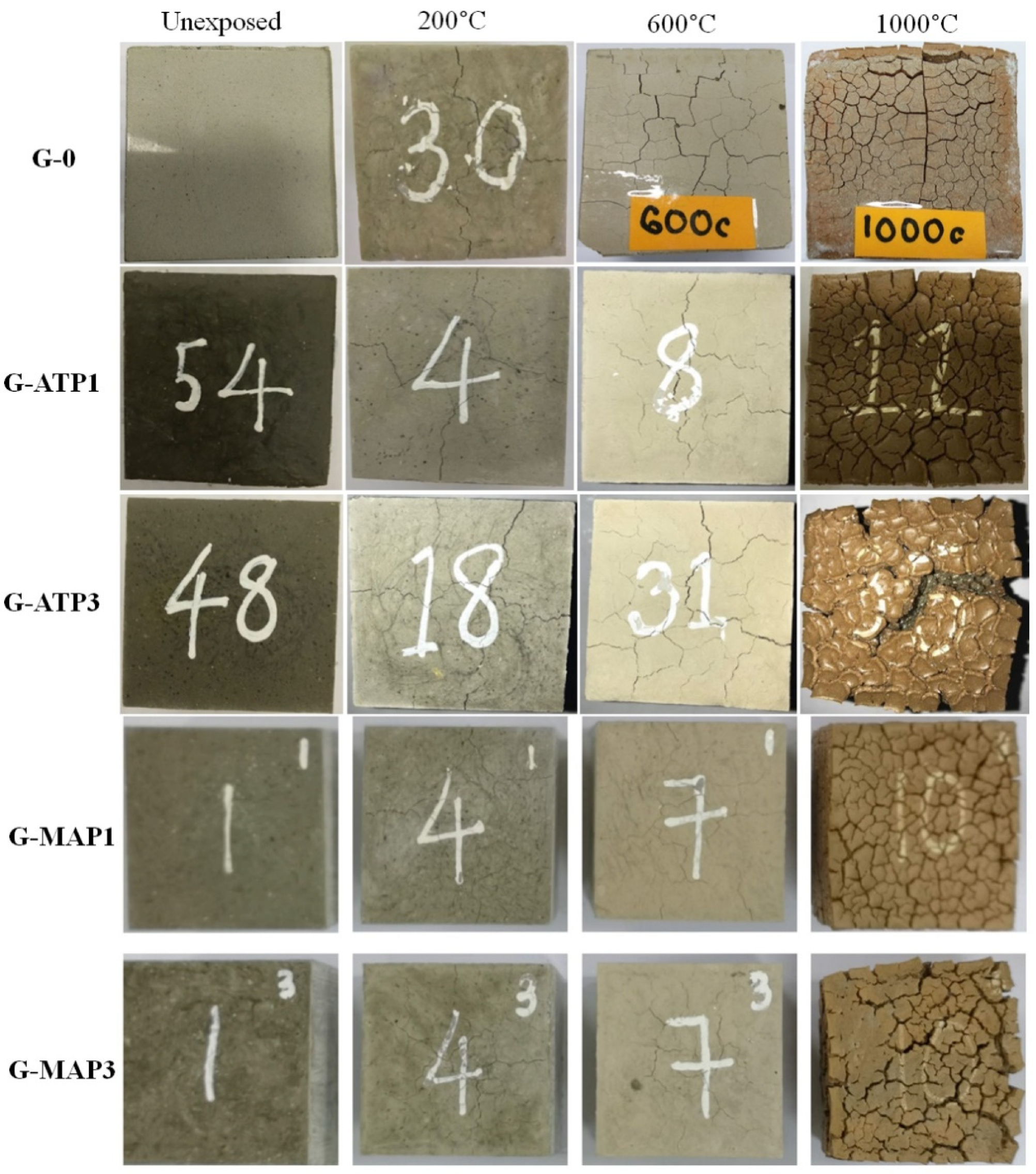

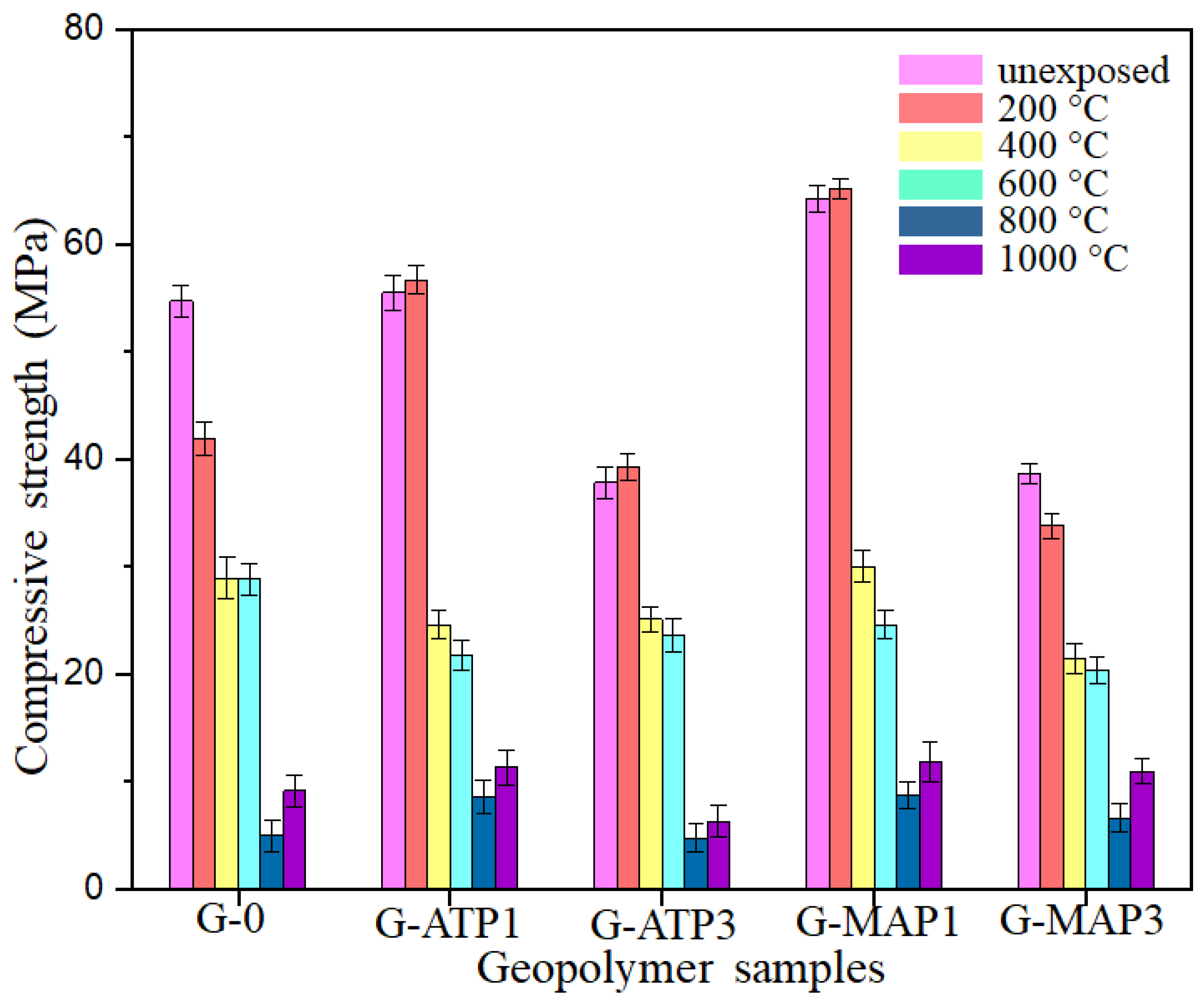
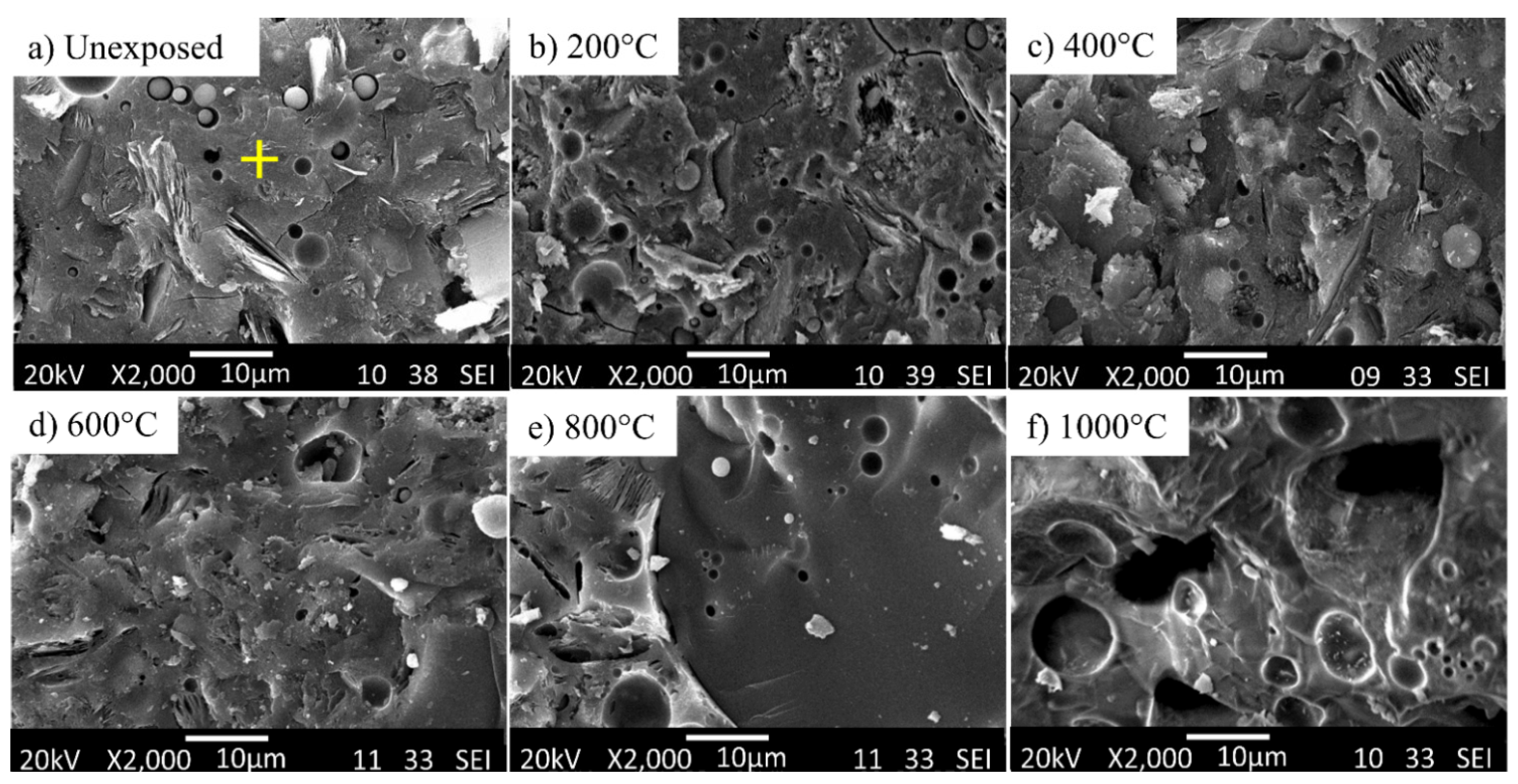
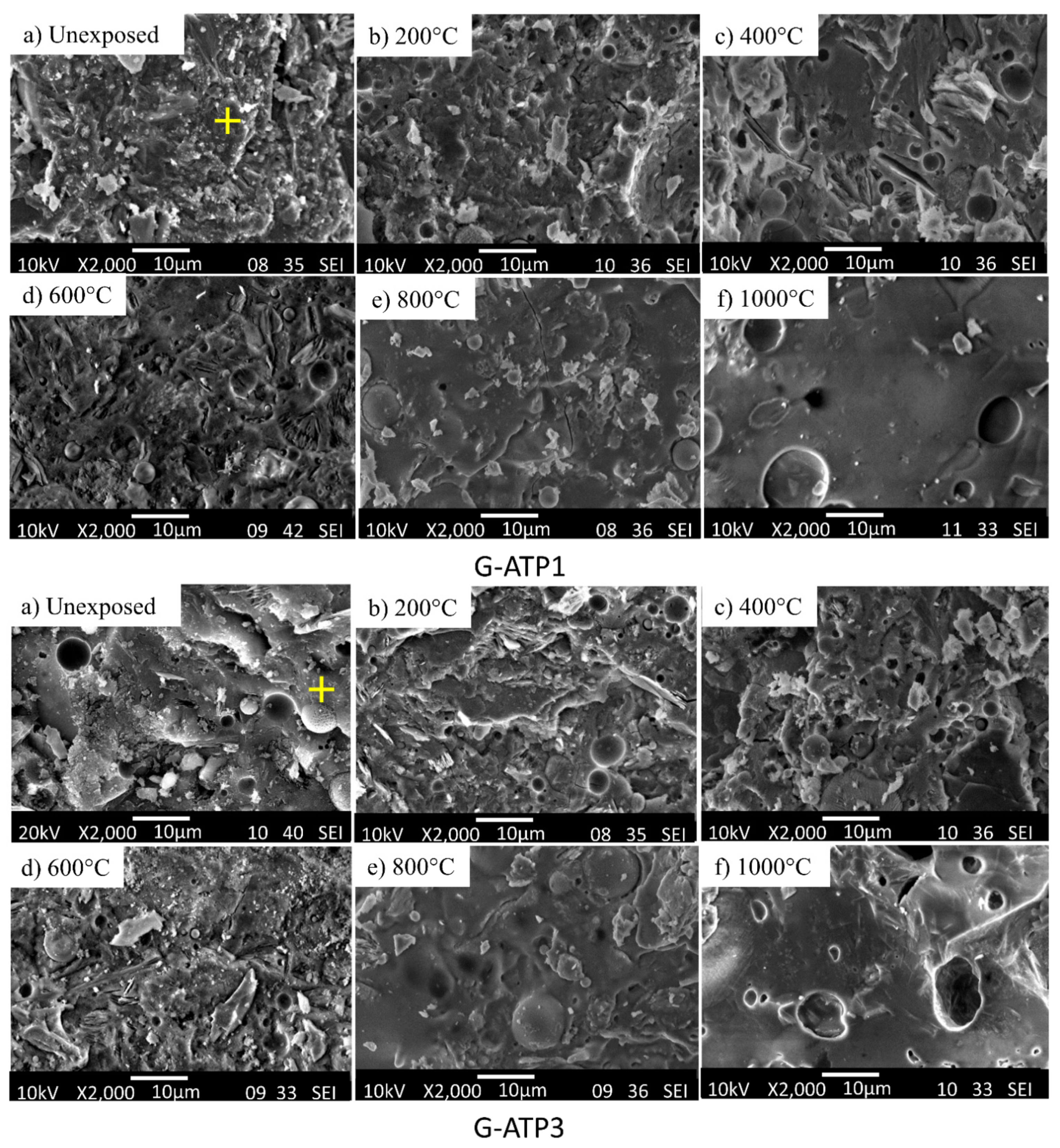
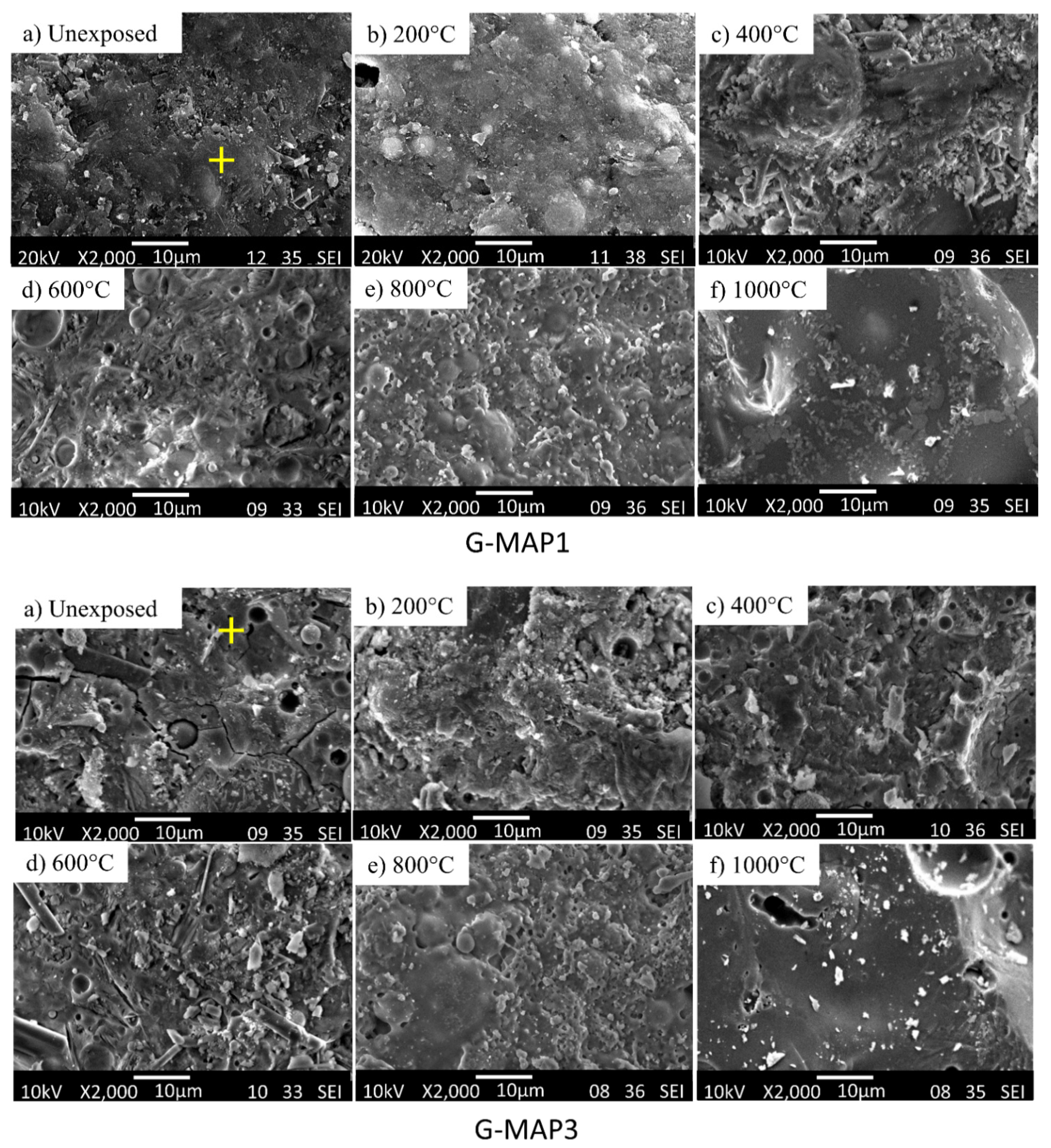
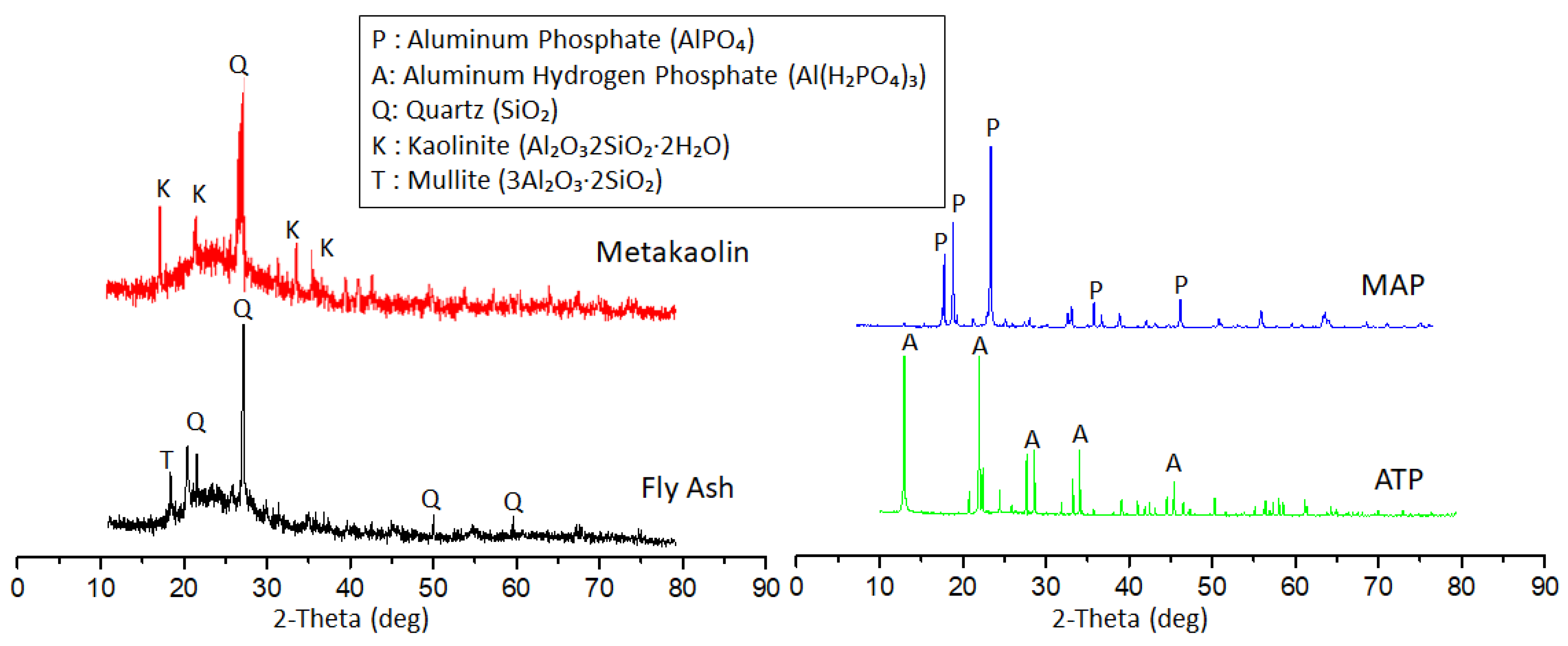

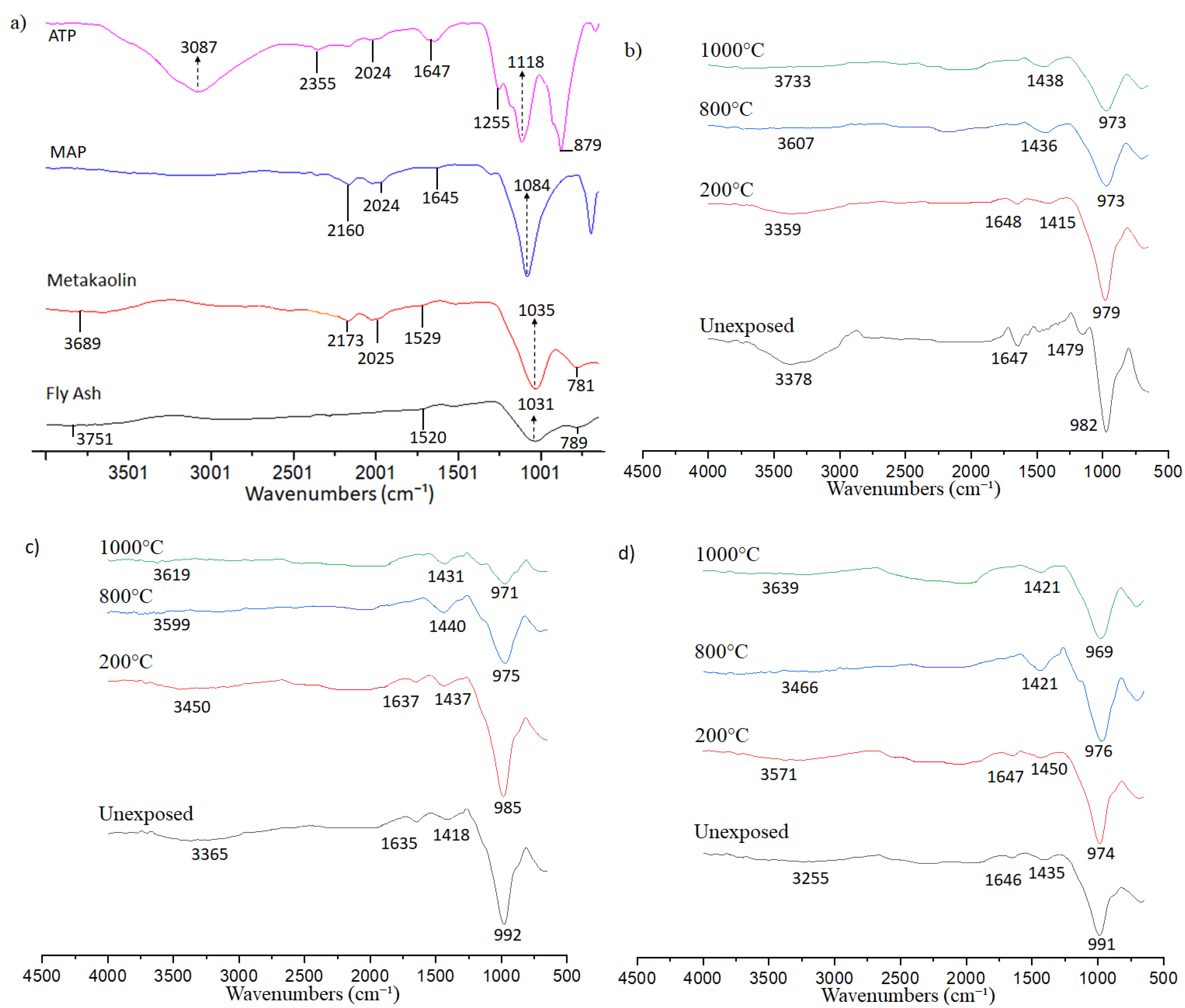
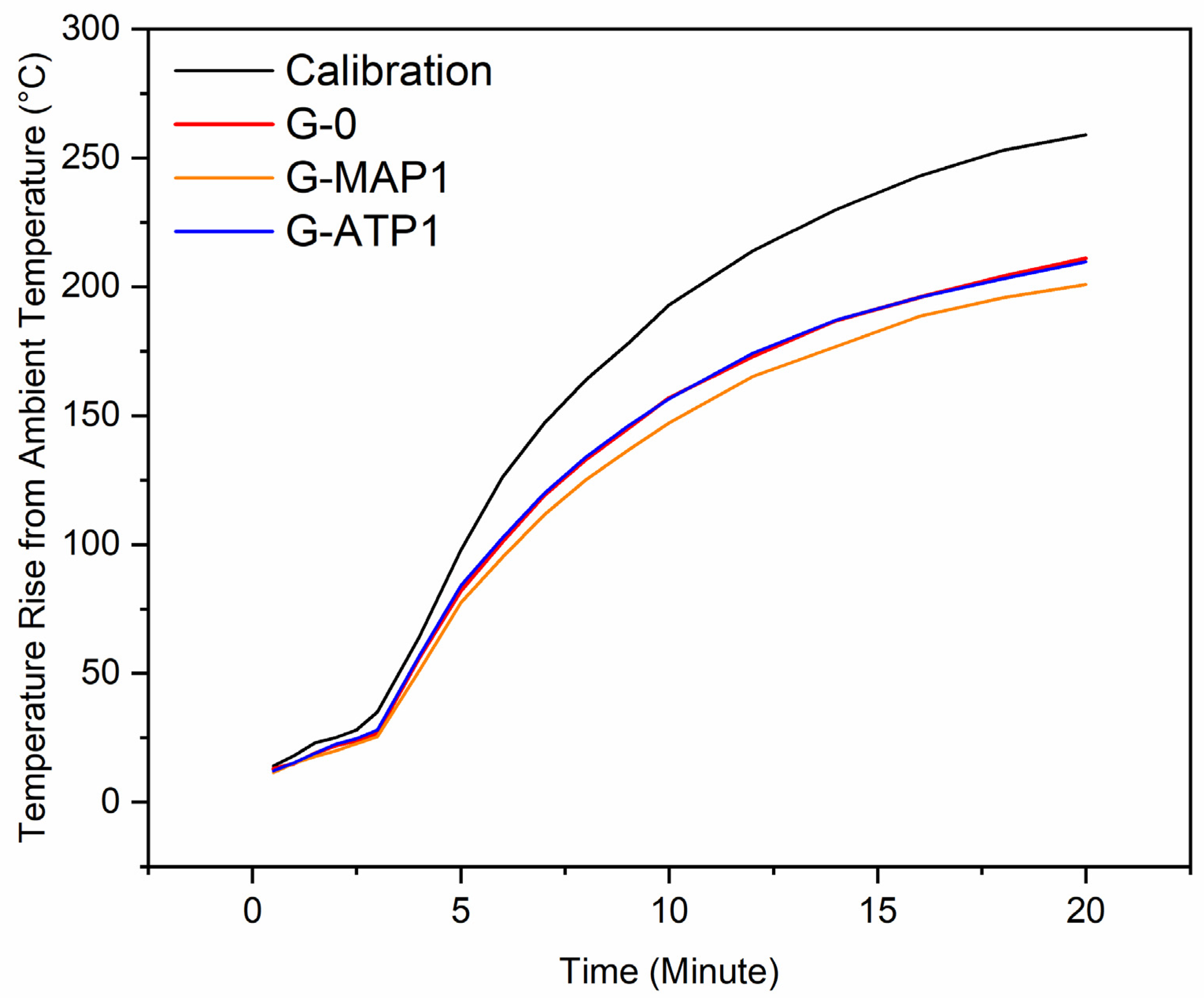

| Compound | FA | MK | MAP | ATP |
|---|---|---|---|---|
| SiO2 | 56.30 | 55.70 | - | - |
| Al2O3 | 28.00 | 38.60 | - | - |
| CaO | 3.89 | - | - | - |
| Fe2O3 | 6.86 | 2.03 | - | - |
| K2O | 1.49 | 2.43 | - | - |
| TiO2 | 2.17 | 0.78 | - | - |
| Na2O | 1.49 | 2.43 | - | - |
| ZrO2 | 0.14 | 0.04 | - | - |
| Others | 0.14 | 0.04 | - | - |
| Al | - | - | 22.10 | 8.50 |
| O | - | - | 52.50 | 60.40 |
| P | - | - | 25.40 | 29.20 |
| H | - | - | - | 1.90 |
| Element | Weight Percentage (wt.%) | ||||
|---|---|---|---|---|---|
| G-0 | G-ATP1 | G-ATP3 | G-MAP1 | G-MAP3 | |
| Na | 10.75 | 15.71 | 9.98 | 8.51 | 10.65 |
| Al | 16.18 | 14.57 | 14.12 | 20.62 | 15.46 |
| Si | 29.46 | 20.54 | 30.96 | 33.36 | 29.46 |
| P | - | 0.87 | 2.21 | 1.49 | 2.02 |
| Specimen Reference | G-0 | G-ATP1 | G-MAP1 | |||
|---|---|---|---|---|---|---|
| Density (kg/m3) | 1699 | 1635 | 1528 | |||
| Temperature Measurement | CH 1 | CH 2 | CH 1 | CH 2 | CH 1 | CH 2 |
| Maximum Temperature (°C) | 753 | 709 | 748 | 707 | 751 | 741 |
| Stabilized Temperature (°C) | 750 | 750 | 750 | |||
| Temperature Difference (°C) | 3 | - | - | - | 1 | - |
| Designation of Material | Noncombustible | Noncombustible | Noncombustible | |||
| Sample | i1 | i2 | i3 | Fire Propagation Index (i) |
|---|---|---|---|---|
| G-0 | 0.1 | 0.0 | 0.0 | 0.1 |
| G-ATP1 | 0.0 | 0.0 | 0.0 | 0.0 |
| G-MAP1 | 0.0 | 0.0 | 0.0 | 0.0 |
Publisher’s Note: MDPI stays neutral with regard to jurisdictional claims in published maps and institutional affiliations. |
© 2021 by the authors. Licensee MDPI, Basel, Switzerland. This article is an open access article distributed under the terms and conditions of the Creative Commons Attribution (CC BY) license (https://creativecommons.org/licenses/by/4.0/).
Share and Cite
Zulkifly, K.; Cheng-Yong, H.; Yun-Ming, L.; Bayuaji, R.; Abdullah, M.M.A.B.; Ahmad, S.B.; Stachowiak, T.; Szmidla, J.; Gondro, J.; Jeż, B.; et al. Elevated-Temperature Performance, Combustibility and Fire Propagation Index of Fly Ash-Metakaolin Blend Geopolymers with Addition of Monoaluminium Phosphate (MAP) and Aluminum Dihydrogen Triphosphate (ATP). Materials 2021, 14, 1973. https://doi.org/10.3390/ma14081973
Zulkifly K, Cheng-Yong H, Yun-Ming L, Bayuaji R, Abdullah MMAB, Ahmad SB, Stachowiak T, Szmidla J, Gondro J, Jeż B, et al. Elevated-Temperature Performance, Combustibility and Fire Propagation Index of Fly Ash-Metakaolin Blend Geopolymers with Addition of Monoaluminium Phosphate (MAP) and Aluminum Dihydrogen Triphosphate (ATP). Materials. 2021; 14(8):1973. https://doi.org/10.3390/ma14081973
Chicago/Turabian StyleZulkifly, Khairunnisa, Heah Cheng-Yong, Liew Yun-Ming, Ridho Bayuaji, Mohd Mustafa Al Bakri Abdullah, Shamsul Bin Ahmad, Tomasz Stachowiak, Janusz Szmidla, Joanna Gondro, Bartłomiej Jeż, and et al. 2021. "Elevated-Temperature Performance, Combustibility and Fire Propagation Index of Fly Ash-Metakaolin Blend Geopolymers with Addition of Monoaluminium Phosphate (MAP) and Aluminum Dihydrogen Triphosphate (ATP)" Materials 14, no. 8: 1973. https://doi.org/10.3390/ma14081973
APA StyleZulkifly, K., Cheng-Yong, H., Yun-Ming, L., Bayuaji, R., Abdullah, M. M. A. B., Ahmad, S. B., Stachowiak, T., Szmidla, J., Gondro, J., Jeż, B., Khalid, M. S. B., Garus, S., Shee-Ween, O., Wan-En, O., & Hui-Teng, N. (2021). Elevated-Temperature Performance, Combustibility and Fire Propagation Index of Fly Ash-Metakaolin Blend Geopolymers with Addition of Monoaluminium Phosphate (MAP) and Aluminum Dihydrogen Triphosphate (ATP). Materials, 14(8), 1973. https://doi.org/10.3390/ma14081973








